Registered Behavior Technician (RBT) Cover Letter

Introduction to the Role and Application Process for RBTs
The role of a Registered Behavior Technician (RBT) is crucial in delivering evidence-based behavioral interventions, primarily for individuals with autism spectrum disorder and other behavioral challenges. As an aspiring RBT, understanding how to present yourself effectively through a compelling cover letter can significantly impact your chances of securing a position. This article explores the responsibilities of an RBT, the qualification process, and comprehensive guidance on creating tailored, impactful cover letters that highlight your skills, experience, and passion.
Understanding the Role of a Registered Behavior Technician (RBT)
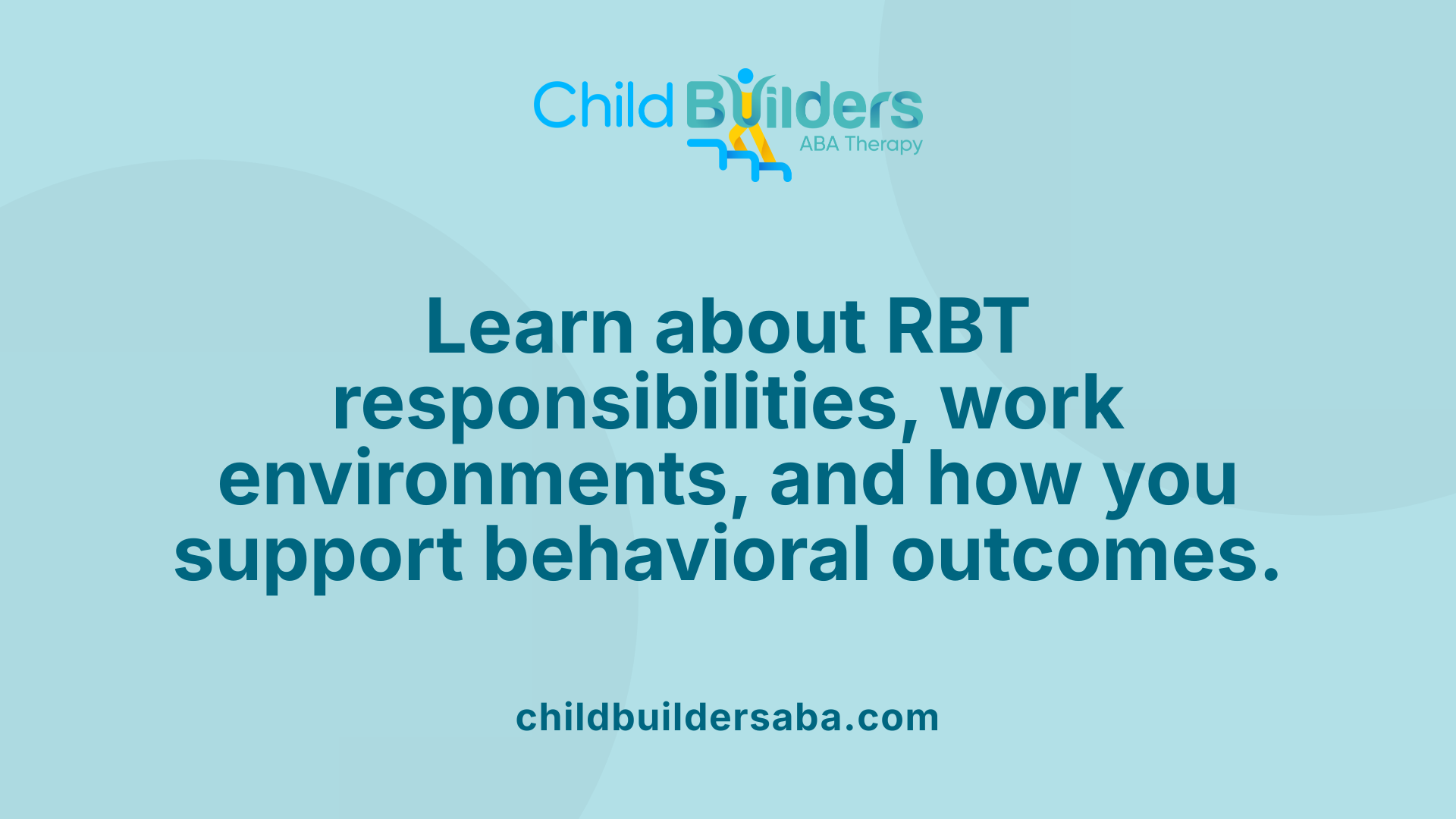
What is the role of a Registered Behavior Technician (RBT)?
A Registered Behavior Technician (RBT) serves as a paraprofessional who works closely under the supervision of a Board Certified Behavior Analyst (BCBA). Their primary responsibility is to provide direct behavioral health services, especially for individuals with autism spectrum disorder and other behavioral challenges.
RBTs assist in implementing detailed behavior-analytic treatment plans that have been developed by supervising professionals. This includes teaching clients new skills, reducing problematic behaviors, and systematically collecting data to monitor progress.
They operate in diverse environments such as clinics, homes, schools, and hospitals. In these settings, RBTs work directly with clients and often collaborate with families and other team members to ensure consistency and effectiveness of interventions.
Their role emphasizes adherence to ethical standards, ongoing supervision, and continuous professional development through training, passing certification exams, and renewing their certification as required.
Overall, RBTs are essential in delivering evidence-based interventions that help enhance behavioral and skill development outcomes for clients. Their hands-on work supports broader therapy goals and contributes significantly to the success of behavioral treatment programs.
Eligibility and Qualification Requirements for Aspiring RBTs
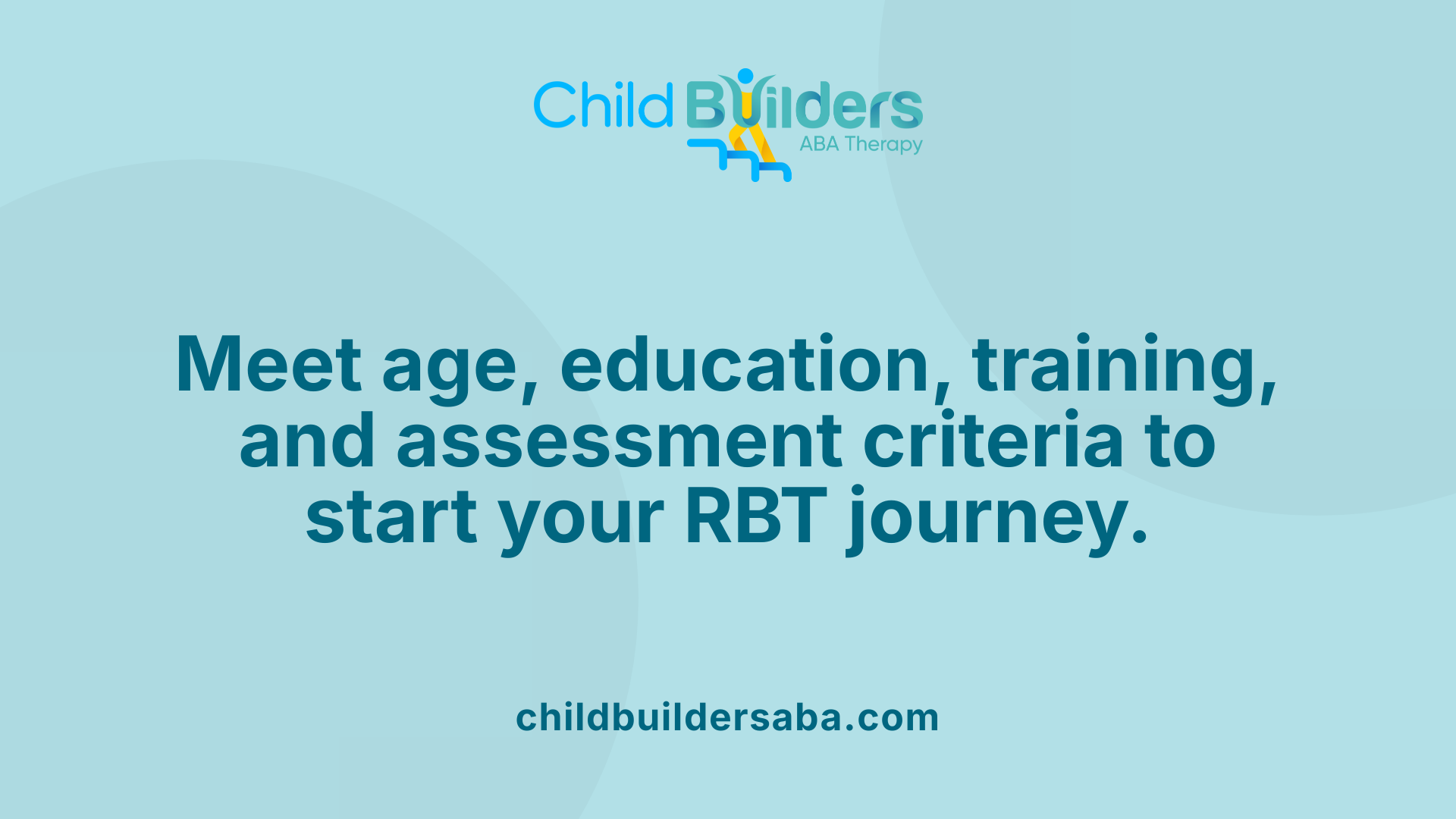
What are the requirements and qualifications to become an RBT?
Becoming a Registered Behavior Technician (RBT) involves meeting several educational and professional criteria. First, candidates must be at least 18 years old, ensuring they have the maturity necessary to work with individuals with behavioral needs.
A high school diploma or its equivalent is also required. This foundational educational level prepares applicants to understand complex treatment plans and ethical standards in behavioral therapy.
Next, aspiring RBTs must complete a 40-hour training course. This training covers essential topics, including the RBT Task List, ethics, and professional conduct. The training can be taken either online or in person, providing flexibility for different learning preferences.
Following training, candidates are required to pass a criminal background check to ensure they meet safety standards essential for working with vulnerable populations.
Once background clearances are obtained, applicants need to demonstrate practical skills through an RBT Competency Assessment, which must be completed within 90 days of application. This assessment evaluates their ability to implement treatment plans correctly and ethically.
Subsequently, they must apply through the Behavior Analyst Certification Board (BACB), pay the required fees ($50 application fee and $45 exam fee), and sit for the certification exam. The exam, administered via Pearson VUE, comprises 75 multiple-choice questions covering various topics such as assessment, behavior reduction, documentation, measurement, and skill acquisition.
Maintaining the certification involves ongoing supervision — at least 5% of the hours providing ABA services must be supervised, with at least two face-to-face sessions per month (which can be virtual). Renewals are required annually, with adherence to BACB ethical standards.
This structured pathway ensures that only qualified and ethical professionals serve in the important role of an RBT, supporting effective behavioral interventions across different settings.
Cost and Examination Details for Prospective RBTs
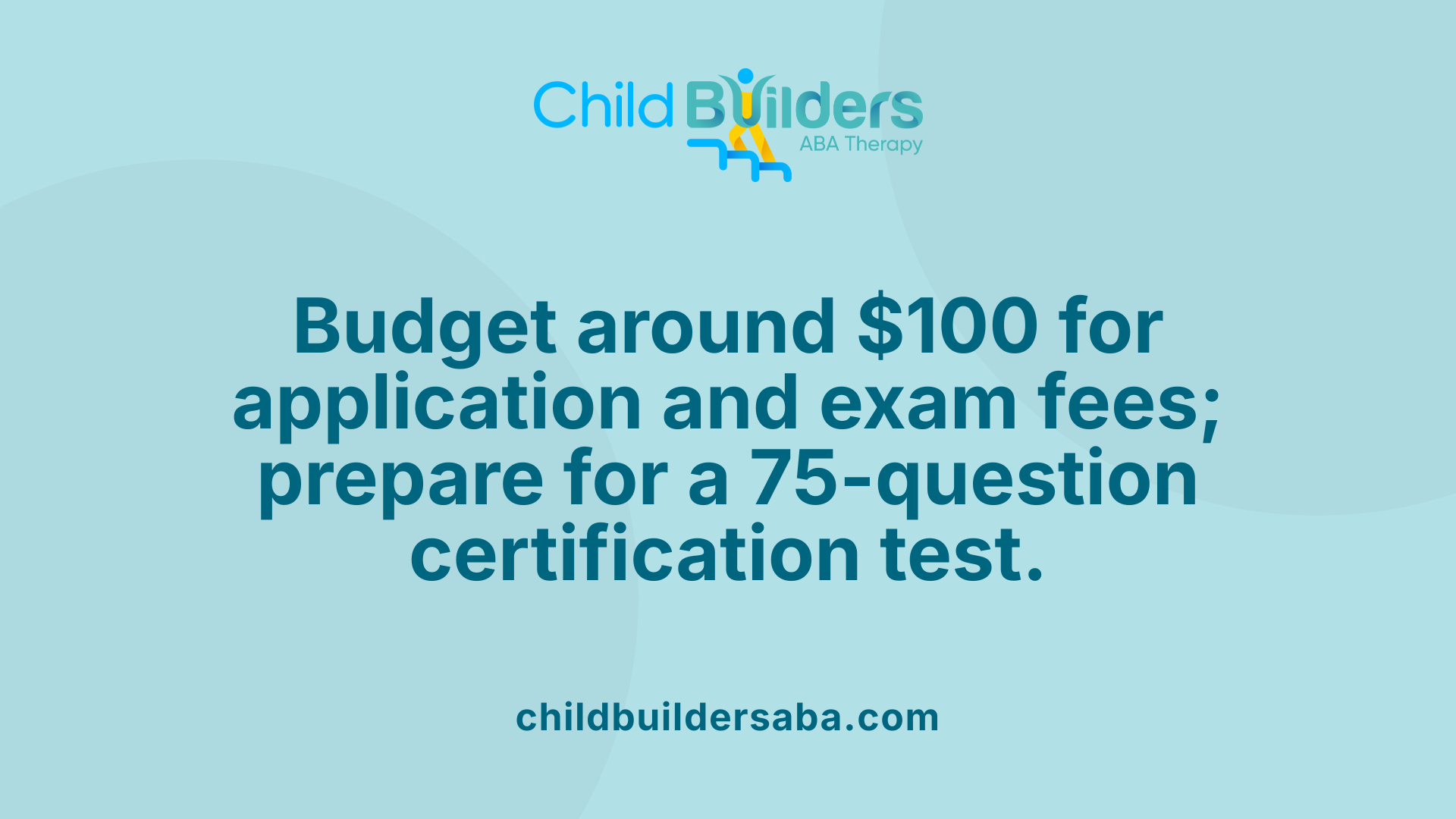
How much does it cost to become an RBT?
To pursue a career as a Registered Behavior Technician, the financial investment is relatively modest. The total cost is approximately $100, which covers essential application and examination fees. Specifically, applicants must pay a $50 application fee, along with a $45 exam fee.
This expense underscores the accessibility of the RBT credential, making it feasible for many individuals interested in entering the field of behavior analysis. It’s important for prospective RBTs to budget for these costs early in their planning process to ensure they meet all financial requirements before starting their training and certification journey.
What does the RBT exam entail?
The certification exam for RBTs is a critical step in validating their readiness to perform ABA interventions under supervision. The exam consists of 75 multiple-choice questions that assess knowledge across several key areas.
These areas include assessment procedures, behavior reduction strategies, documentation practices, measurement techniques, ethical and professional conduct, and skill acquisition methods. The questions are designed to evaluate not only theoretical understanding but also the practical application of ABA principles.
Preparing for this exam involves studying the RBT Task List, which details the core responsibilities and skills expected of an RBT. Many resources, including practice tests and review courses, are available online to help candidates familiarize themselves with the exam format and typical questions.
Ongoing supervision and recertification
After certification, RBTs are required to work under supervision—at least 5% of the hours they provide ABA services must be supervised. This supervision involves at least two face-to-face sessions each month, which can also be conducted virtually.
Continuous oversight ensures that RBTs maintain competency and adhere to ethical standards. Periodic recertification is necessary to keep the credential active, emphasizing the importance of ongoing professional development.
| Aspect | Requirement | Additional Details |
|---|---|---|
| Training Cost | Around $100 | Includes application and exam fees |
| Exam Format | 75 multiple-choice questions | Focuses on assessment, behavior reduction, documentation, measurement, ethics, and skill acquisition |
| Supervision | Minimum 5% of service hours | At least two face-to-face supervision sessions per month, virtual options included |
| Recertification | Every 1-2 years | Requires ongoing supervision and professional development |
This structured approach ensures that RBTs are well-prepared and continuously supported as they develop their skills in behavior analysis.
For more detailed information on costs, exam structure, and requirements, prospective candidates can search for "RBT exam details and costs" to access the latest resources and official guidelines.
The Supervision and Recertification Framework for RBTs
What are the supervision requirements for RBTs?
Registered Behavior Technicians (RBTs) are required to work under supervision to ensure quality care and adherence to ethical standards. Specifically, they must be supervised for at least 5% of the time they are providing Applied Behavior Analysis (ABA) services. This supervision often involves direct oversight from a Board Certified Behavior Analyst (BCBA).
Moreover, RBTs need to participate in at least two face-to-face supervision sessions each month, which can be conducted in person or virtually. These sessions are essential for ongoing training, feedback, and case review, helping RBTs refine their skills and ensure they are delivering effective ABA interventions.
How often are face-to-face supervision sessions conducted?
The standard for supervision includes a minimum of two face-to-face meetings per month. While in-person meetings are traditional, virtual supervision has become increasingly common, especially in remote or hybrid work settings. These meetings are crucial for discussing client progress, addressing challenges, and maintaining ethical practice standards.
What is the recertification process and standards?
For RBTs to maintain their certification, they must adhere to recertification standards set by the Behavior Analyst Certification Board (BACB). This involves completing ongoing continuing education credits, accumulating a specified number of hours related to ABA practices.
Recertification is typically required every year or two, depending on BACB guidelines. During this period, RBTs must log their supervision hours, complete relevant training, and demonstrate continued competence in their role.
Overview of supervision and recertification in a table
| Aspect | Requirements | Details |
|---|---|---|
| Supervision during service | At least 5% of service hours | Supervision can be virtual or in person |
| Face-to-face sessions | Minimum of two per month | In person or virtual |
| Recertification cycle | Every 1-2 years | Includes ongoing education and supervision hours |
| Continuing education | Specific hours required, aligned with BACB standards | Focused on ABA practices and ethical standards |
This structured supervision and recertification process ensures RBTs stay competent and compliant with industry standards, ultimately fostering better client outcomes and professional growth.
Developing an Effective Cover Letter for RBT Positions
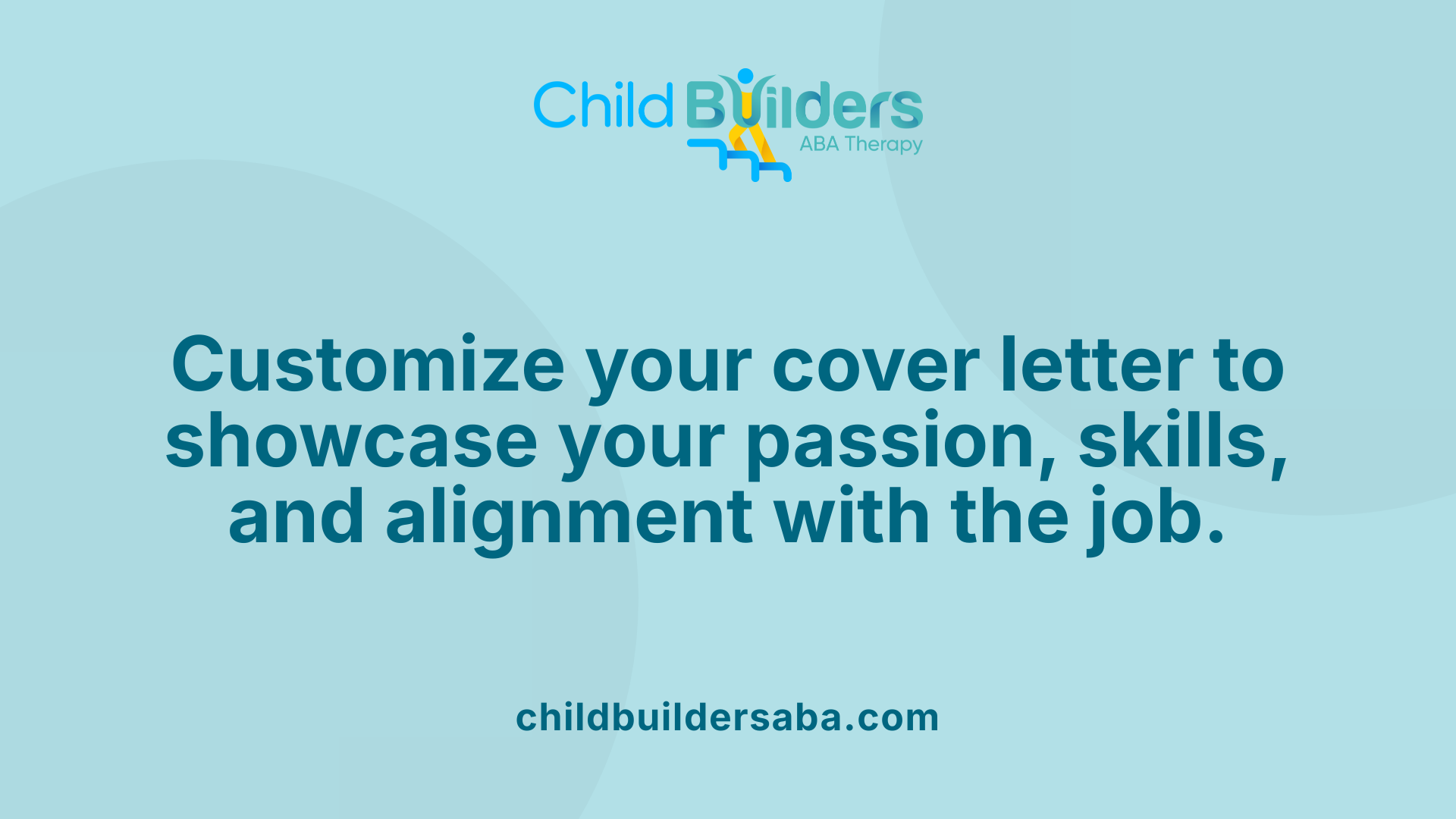
How do I write a compelling cover letter for an RBT position?
Writing a strong cover letter for a Registered Behavior Technician (RBT) role is essential to stand out in a competitive job market. Begin by clearly showcasing your BACB RBT certification, including the date of your certification. This immediately establishes your credibility and compliance with industry standards.
Highlight your practical experience in ABA therapy and other related skills. For example, mention your work with behavior management techniques, communication tools like Picture Exchange Communication System (PECS), and caseload management. Sharing specific results you have achieved, such as reducing challenging behaviors by a measurable percentage or enhancing communication skills in clients, helps demonstrate your effectiveness.
Soft skills are crucial in this field; emphasize your compassion, teamwork, communication, and interpersonal abilities. Explain how these qualities enable you to build trust with clients and collaborate effectively with supervisors and families.
Tailoring your cover letter to each employer increases your chances of success. Match your skills and experiences with the specific needs of the organization. Express enthusiasm about supporting clients' growth and contributing to their progress.
Additionally, including relevant qualifications such as volunteer work, memberships in professional organizations, or publications can further reinforce your dedication and expertise. This personalized and detailed approach shows your commitment and readiness to excel as an RBT.
Ultimately, a compelling cover letter complements your resume by highlighting your unique value and motivates employers to consider you for the role.
Utilizing Templates and Sample Cover Letters Effectively
Are there templates or examples of effective RBT cover letters?
Yes, there are many templates and sample cover letters available online that can serve as helpful guides for creating an effective RBT cover letter. These resources typically include examples that highlight how to effectively showcase relevant experience, such as working with individuals with autism spectrum disorder (ASD), and emphasize important certifications like the RBT credential.
Many of these templates also provide tips on personalizing your introduction, expressing genuine enthusiasm for the role, and demonstrating your passion for helping others. This personal touch can make your application stand out to employers.
In addition to content guidance, these samples stress the importance of clear formatting, proofreading, and maintaining a professional tone. Presenting your qualifications in a clean, organized way helps create a strong first impression.
Using these sample letters as a starting point allows you to tailor your application to better reflect your unique skills and experiences. By customizing templates, you ensure that your cover letter effectively highlights your achievements and your motivation for pursuing a role as an RBT.
Customization tips for RBT cover letters
When adapting a template for your own use, consider the following tips:
- Highlight specific accomplishments: Mention instances where you have successfully reduced challenging behaviors, developed individualized treatment plans, or collaborated with families and teams.
- Emphasize relevant experience: Include any direct work with individuals with ASD or in similar settings, along with measurable outcomes.
- Showcase certifications: Clearly state your RBT certification, including the date obtained and any ongoing professional development.
- Express enthusiasm and fit: Share why you are passionate about behavior analysis and how your goals align with the employer's mission.
- Tailor to the employer: Research the organization and mention how your skills can meet their specific needs or values.
Highlighting achievements and skills
Effectively showcasing your accomplishments and skills can significantly improve your chances of landing an interview. Here are some ways to do so:
| Achievement or Skill | How to Highlight It | Impact to Employer |
|---|---|---|
| Behavior Reduction | Mention specific strategies used and results achieved | Demonstrates ability to improve client well-being |
| Collaboration with Teams | Provide examples of working with BCBAs, families, and caregivers | Shows teamwork and communication skills |
| Data Collection & Documentation | Emphasize accuracy and attention to detail | Ensures quality client records and progress tracking |
| Compassion and Patience | Share personal motivation and examples | Reflects suitability for sensitive work |
Final thoughts
Whether you are just starting out or seeking to enhance your application, utilizing well-crafted templates and sample cover letters can streamline the process. Customizing your cover letter to highlight relevant experiences and demonstrate your passion will help you stand out in a competitive field.
By combining professional templates, personalized content, and measurable achievements, you can craft a compelling cover letter that effectively presents your qualifications and enthusiasm for the RBT role. Remember, a thoughtful, tailored application reflects your dedication and helps make a strong impression on potential employers.
Showcasing Skills and Achievements in Your Cover Letter
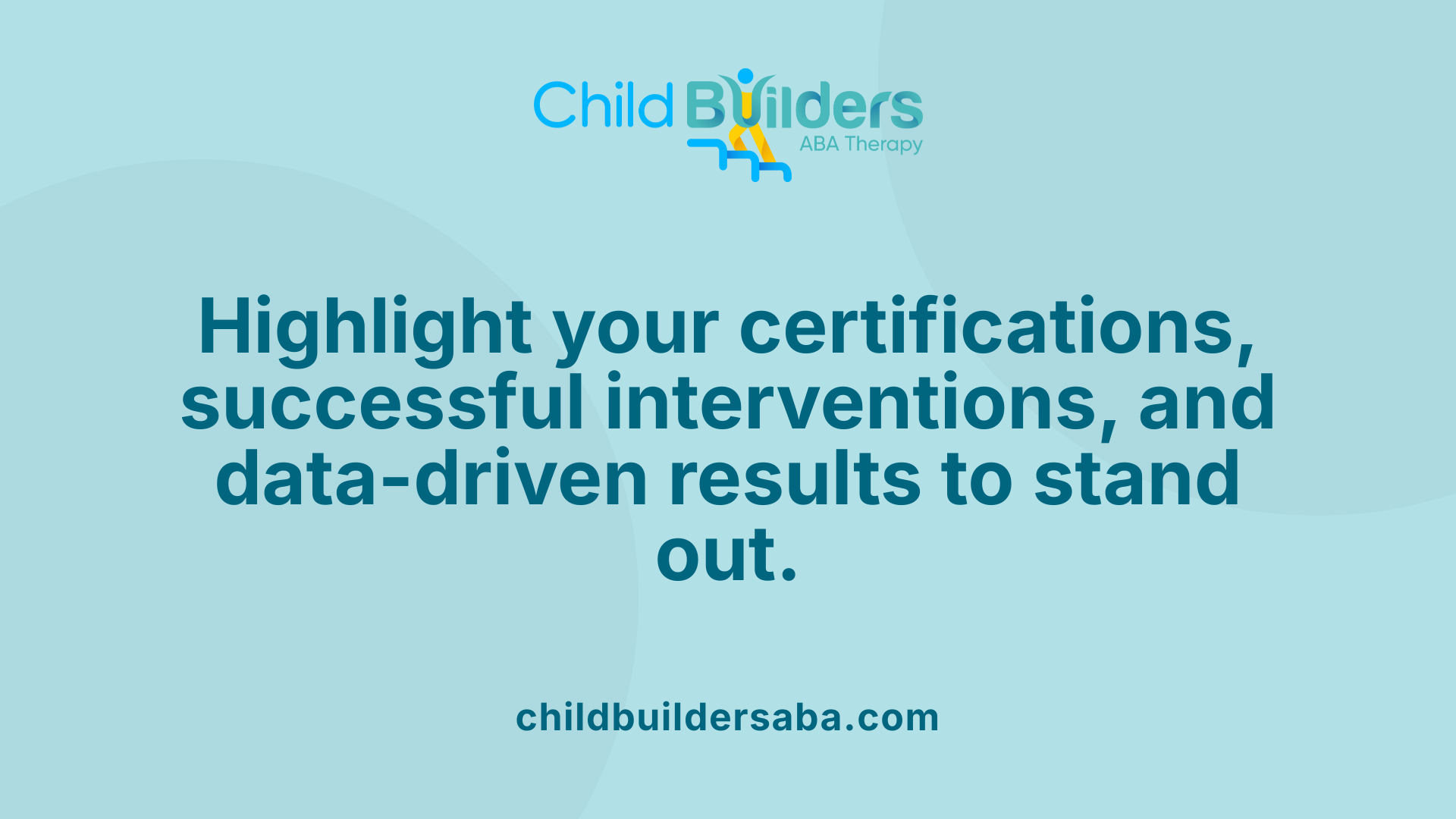
What should I include in my RBT cover letter to showcase my skills?
When applying for a Registered Behavior Technician (RBT) position, your cover letter presents a valuable opportunity to highlight your relevant skills and experience. Start by mentioning your certifications, especially your RBT credential, and any related educational background such as coursework in psychology or behavior analysis.
Be specific about your hands-on experience with Applied Behavior Analysis (ABA) techniques. Discuss your familiarity with developing and implementing behavior intervention plans, and emphasize your proficiency in data collection and analysis. Providing examples of how you have used data to track progress or modify interventions demonstrates your practical understanding of ABA principles.
Collaborate your technical skills with soft skills. Mention your abilities in communication, patience, empathy, and teamwork. For example, describe situations where your patience helped a child overcome a challenging behavior or how your teamwork facilitated better outcomes with colleagues and family members.
Personalization is essential. Address the hiring manager directly if possible and express genuine enthusiasm for working with individuals with autism spectrum disorder (ASD) or developmental delays. Show that you've researched the organization and align your passion with its mission.
Ensure your cover letter reflects a clear understanding of ABA and the responsibilities of an RBT. A professional, enthusiastic tone combined with concrete examples enhances your chances of making a positive impression.
Skills to Highlight in Your RBT Application
| Skill Area | Examples | Additional Tips |
|---|---|---|
| Certifications | RBT credential, relevant coursework | Highlight any specialized training in behavior analysis |
| Experience with ABA | Developing intervention plans, behavior reduction | Describe specific cases or populations you've worked with |
| Data Collection & Plans | Tracking progress, adjusting plans | Mention tools or software used, and how data improved client outcomes |
| Soft Skills | Patience, empathy, communication | Share scenarios demonstrating your interpersonal skills |
| Team Collaboration | Working with families and multi-disciplinary teams | Emphasize your ability to work collaboratively for client success |
By thoughtfully incorporating these elements, you can craft a compelling cover letter that not only showcases your skills but also resonates with hiring managers and reflects your dedication to making a difference in clients' lives.
Best Practices for Formatting and Structuring Your Cover Letter
What are best practices for formatting and structuring an RBT cover letter?
When applying for a Registered Behavior Technician (RBT) position, a well-structured cover letter can make a significant difference. Use a professional layout that is clean and easy to read, typically with standard fonts such as Times New Roman or Arial, size 10-12, and consistent spacing.
Start with a header that includes your contact information, followed by the date and the employer's details. Personalize each letter by addressing it directly to the hiring manager, if possible, avoiding generic greetings.
The introduction should express your enthusiasm for the role, mentioning how you learned about the position and briefly highlighting relevant ABA experience or motivation.
In the body paragraphs, focus on your skills and accomplishments that demonstrate your capability as an RBT. This may include experience in designing or implementing behavior intervention plans, collecting and analyzing data, or working effectively with clients and families. Include specific examples, such as reducing challenging behaviors by a certain percentage or successfully collaborating with a team.
Highlight soft skills like empathy, patience, and teamwork, which are essential for success in ABA therapy. Show how your understanding of ABA principles aligns with the company’s goals.
Conclude with a strong closing paragraph that expresses eagerness for an interview, thanks the employer for their consideration, and provides your contact information.
Keep the tone professional and error-free throughout. Use concise language, and avoid overly long sentences. Pay attention to proper formatting, including uniform font, margins, and spacing to ensure your letter is easy to scan.
By following these guidelines, your cover letter will stand out and effectively showcase your qualifications, increasing your chances of securing an interview.
Enhancing and Tailoring Your Cover Letter for Different Opportunities
Personalization and Research
When applying for RBT positions, customizing your cover letter for each opportunity can make a significant difference. Start by researching the organization thoroughly — learn about their mission, the populations they serve, and their specific programs. Incorporate this information into your letter to demonstrate genuine interest and a tailored approach. Addressing the hiring manager by name, if possible, adds a personal touch that shows extra effort.
Matching Skills with Job Needs
A successful cover letter clearly connects your skills and experiences with what the employer is seeking. Highlight relevant background such as your experience implementing ABA therapy, working with children or adults with autism, or developing individualized treatment plans. Use specific examples of achievements, like reducing challenging behaviors or collaborating with families, to illustrate your capabilities.
Professional Tone and Proofreading
Keep your tone professional yet enthusiastic, showing your passion for helping individuals with special needs. Use clear and concise language, avoiding jargon that might not be familiar to all readers. Before submitting, proofread your letter carefully for typos and grammatical errors, as these can undermine your professionalism.
How can I improve and tailor my RBT cover letter for different jobs?
To improve and tailor your RBT cover letter for different jobs, start by addressing the hiring manager directly and using their name to add a personal touch. Highlight your relevant experience in ABA and working with individuals with ASD, emphasizing skills that align with the specific requirements of each position. Demonstrate genuine interest and passion for supporting individuals with special needs, while expressing your understanding of the organization’s values and goals. Personalize your cover letter by mentioning specific programs or services the organization offers to show that you've researched them thoroughly. Finally, maintain a professional tone, proofread carefully to avoid errors, and conclude with gratitude to leave a positive impression.
By customizing each application, you increase the likelihood of standing out among other candidates. Employers value candidates who show they understand their organization and are genuinely committed. Remember to align your skills with the job description and highlight how your background makes you a great fit for their team.
| Aspect | Tips | Additional Insights |
|---|---|---|
| Personalization | Use the organization’s name, mention specific programs | Shows genuine interest and effort |
| Skills Match | Highlight ABA experience, behavior management successes | Demonstrates relevant expertise |
| Tone and Quality | Keep professional, enthusiastic, and clear | First impression matters |
| Proofreading | Check for grammar, spelling, and formatting errors | Reflects attention to detail |
Effectively tailoring your cover letter will make a positive impact on potential employers, giving you a competitive edge in the job market.
Additional Resources and Tips for Job Applications in ABA Field
Where can I find online job boards and professional networks for ABA positions?
To increase your chances of securing an RBT role, it's essential to explore a range of online job boards and professional networks. Specialized ABA job websites such as ABA Job Board, Autism Jobs, and BCBA Central are excellent platforms tailored specifically for behavior analysts and RBTs. These sites often feature postings not found elsewhere and offer filters to narrow down opportunities by location, employer type, or employment level.
In addition to niche platforms, leverage broader employment sites like Indeed and LinkedIn, which host a wide array of healthcare and behavioral positions. Building a professional profile on LinkedIn and engaging in relevant groups can connect you with industry professionals and open doors through networking.
Attending conferences, workshops, and local meetups related to ABA can facilitate face-to-face networking and uncover hidden opportunities. Similarly, joining social media groups dedicated to ABA professionals offers ongoing discussion, advice, and job leads.
How can I prepare the best application materials for an RBT position?
Effective application materials are crucial when vying for an RBT role. Start by crafting a tailored resume that highlights your relevant experience, certifications, and skills. Include details such as completed training, specific competencies, and any work you’ve done with children or individuals with developmental disabilities.
A compelling cover letter complements your resume by demonstrating your motivation, understanding of the role, and how your background aligns with the company's values. Use the cover letter template options from professional resources like Resume Worded, which advise emphasizing accomplishments. For example, mention instances where you reduced challenging behaviors or contributed to positive outcomes.
Ensure your resume and cover letter are well-formatted, free of errors, and reflect professionalism. Keep a copy of your 40-hour training certificate and competency assessment ready for submission when prompted.
What ongoing education and certifications can support my ABA career?
Continuing education enhances your skills and keeps you current in the field. Enroll in additional coursework related to behavior analysis, special education, or related health sciences.
Certification upgrades, such as becoming a Board Certified Behavior Analyst (BCBA) or pursuing specialized training in areas like autism spectrum disorder or early intervention, also add value. These credentials can open doors to higher-paying or more specialized positions.
Stay updated on resources by regularly visiting BACB (Behavior Analyst Certification Board) announcements and participating in professional organizations. They often offer workshops, webinars, and seminars that provide both education and networking opportunities.
Quick Reference Table
| Resource Type | Examples | Purpose | Additional Tips |
|---|---|---|---|
| Job Boards | ABA Job Board, Autism Jobs, Indeed | Find available positions | Regularly check and set alerts |
| Professional Networks | LinkedIn Groups, ABA Conferences | Network with professionals | Engage actively and seek mentorship |
| Application Tools | Resume Worded templates, professional writing tips | Improve application quality | Tailor each application to the role |
| Continuing Education | ABA coursework, workshops from BACB | Enhance skills and credentials | Seek certifications aligned with career goals |
Staying proactive with these resources and tips can significantly improve your chances of landing a rewarding RBT role. Consistently updating your skills, engaging with professional communities, and preparing thoroughly for applications are vital steps in advancing your career in ABA.
Final Thoughts: Crafting Your Path to a Successful RBT Career
Landing an RBT position hinges on demonstrating your qualifications, passion, and professionalism through a well-crafted cover letter. By highlighting relevant certifications, practical experience, and soft skills, you build a compelling case for your candidacy. Remember to personalize each application, utilize available templates and examples, and adhere to best formatting practices. Continual professional development and resourcefulness in job searching will further enhance your chances. With the right approach and a sincere commitment to the field, your journey to becoming a valued RBT can be both rewarding and impactful.
References
- How to Become a Registered Behavior Technician
- 14 Behavioral Therapist Cover Letter Examples - Resume Worded
- RBT Resume: Registered Behavior Tech Examples & Guide - Zety
- Finding RBT Job Opportunities: Tips for Finding and Applying for ...
- 5 Must-Know RBT Application Tips - Behavior Analyst Certification ...
- RBT training and career development resources - Ensora Health
- [PDF] 2025 RBT Application Update: Overview and Resources - BACB





.jpg)































































































